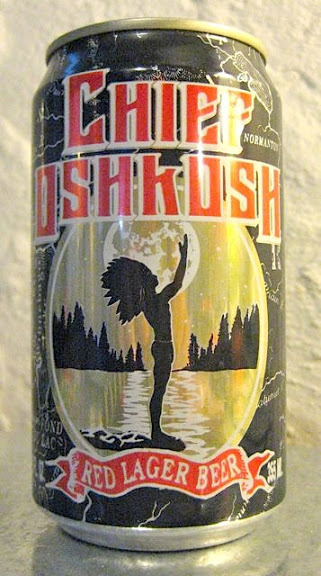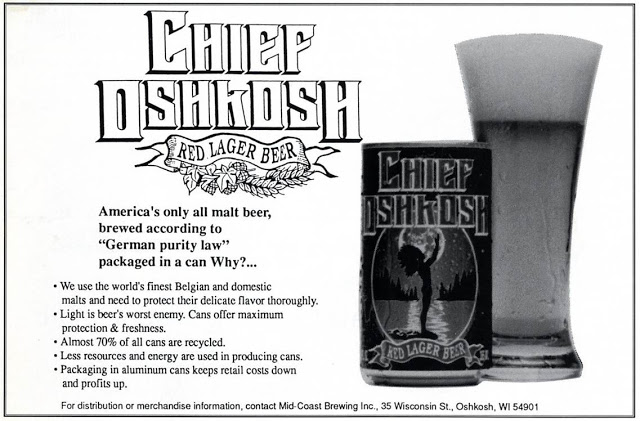Can You Believe It? It’s Been a Quarter-Century Since the First Micro-Brew Cans
 On Monday, June 17, 1991, new Mid-Coast Brewing Co. formally unveiled its Chief Oshkosh Red Lager at a Hilton hotel in downtown Oshkosh, Wis. The event would now otherwise be unremembered 25 years later were it not for one thing: Chief Oshkosh Red Lager came in cans.
On Monday, June 17, 1991, new Mid-Coast Brewing Co. formally unveiled its Chief Oshkosh Red Lager at a Hilton hotel in downtown Oshkosh, Wis. The event would now otherwise be unremembered 25 years later were it not for one thing: Chief Oshkosh Red Lager came in cans.
Mid-Coast Brewing was the brainchild of Jeff Fulbright. A conversation with Boston Beer Co. co-founder Jim Koch at a Great American Beer Festival in the late 1980s had inspired Fulbright to leap into small-scale, more traditional brewing at a time when such a move was rare, especially in the Midwest.
Koch’s own Boston Beer was taking off behind the absurdly popular Samuel Adams Boston Lager and other brands. Fulbright imagined his Chief Oshkosh not necessarily as a competitor with Sam Adams, but more as a Midwestern complement to the East Coast-based Boston Beer.
Fulbright studied at the Siebel Institute, devised the red lager recipe, and ticked the necessary regulatory boxing. He arranged for the Stevens Point Brewery in Eau Claire, 70 miles northwest of Oshkosh, to brew Mid-Coast’s beer under contract. And he made sure he could use the Chief Oshkosh name—it had been a brand until 1971 of the Oshkosh Brewing Co., a defunct Wisconsin regional. The trademark was available. Fulbright grabbed it.
None of these actions were as monumental as Fulbright’s decision to have Stevens Point can the red lager rather than bottle it. The decision was a largely financial one—it was cheaper—but it meant his Mid-Coast Brewing became the first American micro-brewery (as they were then called) to can its beer.
Fulbright’s decision did not mark the start of a trend, however. Other contract operations would throughout the 1990s can their beers, but not because of the Chief Oshkosh example. While distribution would grow to 13 states, with an ambitious plan to go national, Mid-Coast folded in 1994, taking its canned red lager with it. (The collapse likely had something to do with Leinenkugel, a Wisconsin regional that Miller had acquired, introducing its own red lager in 1993.)
 Other contract micro-breweries instead appear to have canned their beers simply to capture that much more of a beer marketplace that Miller and other larger can-comfortable operations dominated. These canned brands in the 1990s included Pete’s Summer Brew from Pete’s Brewing, Wisconsin Amber from Capital Brewery, Brewski Brewing’s Brewski Beer and Iron Range Amber Ale from James Page Brewing. Koch’s Boston Beer would briefly allow Whitbread to can its cream ale under contract in the U.K.
Other contract micro-breweries instead appear to have canned their beers simply to capture that much more of a beer marketplace that Miller and other larger can-comfortable operations dominated. These canned brands in the 1990s included Pete’s Summer Brew from Pete’s Brewing, Wisconsin Amber from Capital Brewery, Brewski Brewing’s Brewski Beer and Iron Range Amber Ale from James Page Brewing. Koch’s Boston Beer would briefly allow Whitbread to can its cream ale under contract in the U.K.
That contract ended in 1999, and many of these canned brands just kind of fell down the memory hole of American brewing. It was not until late 2002 that the trend of micro-breweries canning really began. It’s a famous tale: Dale Katechis’ tiny Oskar Blues Brewery out of Lyons, Colo., manually canned its Dale’s Pale Ale two at a time in an old barn—the first smaller, more traditional U.S. brewery to do so in-house.
Unconsciously, Katechis and Oskar Blues did mimic Fulbright and Mid-Coast in at least one way: The decision to can was largely financial.
Read more Acitelli on History posts.
Tom Acitelli is the author of The Audacity of Hops: The History of America’s Craft Beer Revolution. His most recent book is a history of American fine wine called American Wine: A Coming-of-Age Story. Reach him on Twitter @tomacitelli.

Stevens Point Brewery is in Stevens Point, WI, not Eau Claire.